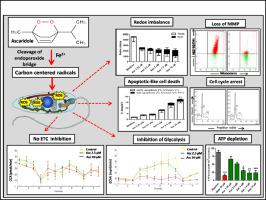Phytomedicine ( IF 6.7 ) Pub Date : 2022-06-03 , DOI: 10.1016/j.phymed.2022.154221 Deblina Sarkar 1 , Sritama De Sarkar 1 , Lars Gille 2 , Mitali Chatterjee 1

|
Background
: The global burden of leishmaniasis is exacerbated by the limited repertoire of drugs, resulting in an urgent need to develop new therapeutic alternatives. Endoperoxides like ascaridole have emerged as promising anti-parasitic candidates, and its effectiveness was established in an animal model of cutaneous leishmaniasis (CL). However, its impact on Leishmania donovani parasites, causative of visceral leishmaniasis (VL) remains to be established.
Purpose
: This study aimed to delineate the underlying mechanisms contributing towards the leishmanicidal effect of ascaridole in terms of its impact on the cellular redox status and metabolic bioenergetics of L. donovani parasites.
Methodology
: The anti-promastigote activity of ascaridole was established by a cell viability assay in L. donovani [MHOM/IN/1983/AG83] and anti-amastigote activity by microscopy and ddPCR (droplet digital polymerase chain reaction). The cellular redox status, mitochondrial membrane potential (MMP), annexin V positivity and cell cycle arrest was evaluated by flow cytometry, while cellular and mitochondrial bioenergetics was assessed using Agilent XFp Analyzer, and the levels of ATP was measured by chemiluminescence.
Results
: Ascaridole demonstrated strong anti-promastigote and anti-amastigote activities in l. donovani, IC50 (half maximal Inhibitory concentration) being 2.47 ± 0.18 µM and 2.00±0.34 µM respectively, while in J774.A1 and murine peritoneal macrophages, the CC50 (half maximal cytotoxic concentration) was 41.47 ± 4.89 µM and 37.58 ± 5.75 µM respectively. Ascaridole disrupted the redox homeostasis via an enhanced generation of reactive oxygen species (ROS), lipid peroxidation and concomitant depletion of thiols. However, it failed to increase the generation of mitochondrial superoxide, which minimally impacted on mitochondrial respiration and was corroborated by energy metabolism studies. Instead, ascaridole inhibited glycolysis of promastigotes, caused a loss in MMP, which translated into ATP depletion. In promastigotes, ascaridole enhanced annexin-V positivity and caused a cell cycle arrest at sub- G0/G1 phase.
Conclusion
: In summary, ascaridole displays its leishmanicidal activity possibly due to its ability to auto-generate free radicals following cleavage of its endoperoxide bridge that led to disruption of the redox homeostasis, inhibition of glycolysis and culminated in an apoptotic like cell death.
中文翻译:

Ascaridole 通过抑制寄生虫糖酵解发挥杀利什曼虫活性
背景
:由于药物种类有限,利什曼病的全球负担更加严重,因此迫切需要开发新的治疗替代品。内过氧化物(如蛔虫)已成为有希望的抗寄生虫候选药物,其有效性已在皮肤利什曼病 (CL) 的动物模型中得到证实。然而,它对多诺瓦尼利什曼原虫的影响,内脏利什曼病 (VL) 的病因仍有待确定。
目的
:本研究旨在根据其对多诺瓦尼寄生虫的细胞氧化还原状态和代谢生物能量学的影响,阐明导致蛔虫杀利什曼虫作用的潜在机制。
方法
:蛔虫的抗前鞭毛体活性是通过L. donovani [MHOM/IN/1983/AG83] 的细胞活力测定和显微镜和 ddPCR(液滴数字聚合酶链反应)的抗鞭毛体活性确定的。通过流式细胞仪评估细胞氧化还原状态、线粒体膜电位 (MMP)、膜联蛋白 V 阳性和细胞周期停滞,而使用 Agilent XFp 分析仪评估细胞和线粒体生物能量学,并通过化学发光测量 ATP 水平。
结果
: Ascaridole 在 l 中表现出强烈的抗前鞭毛体和抗鞭毛体活性。donovani,IC 50(半数最大抑制浓度)分别为 2.47 ± 0.18 µM 和 2.00±0.34 µM,而在 J774.A1 和小鼠腹腔巨噬细胞中,CC 50(最大细胞毒性浓度的一半)分别为 41.47 ± 4.89 µM 和 37.58 ± 5.75 µM。Ascaridole 通过增强活性氧 (ROS) 的生成、脂质过氧化和伴随的硫醇消耗来破坏氧化还原稳态。然而,它未能增加线粒体超氧化物的产生,这对线粒体呼吸的影响最小,并得到了能量代谢研究的证实。相反,蛔虫醇抑制前鞭毛体的糖酵解,导致 MMP 的损失,这转化为 ATP 耗竭。在前鞭毛体中,蛔虫增强了膜联蛋白-V 的阳性并导致细胞周期停滞在亚 G 0 /G 1期。
结论
: 总之,蛔虫具有杀利什曼原虫的活性,这可能是因为它的内过氧化物桥断裂后能够自动产生自由基,从而破坏氧化还原稳态,抑制糖酵解,最终导致细胞凋亡样死亡。











































 京公网安备 11010802027423号
京公网安备 11010802027423号